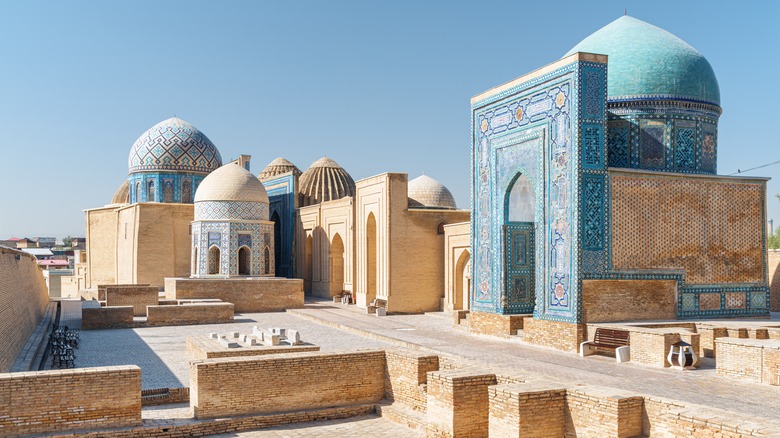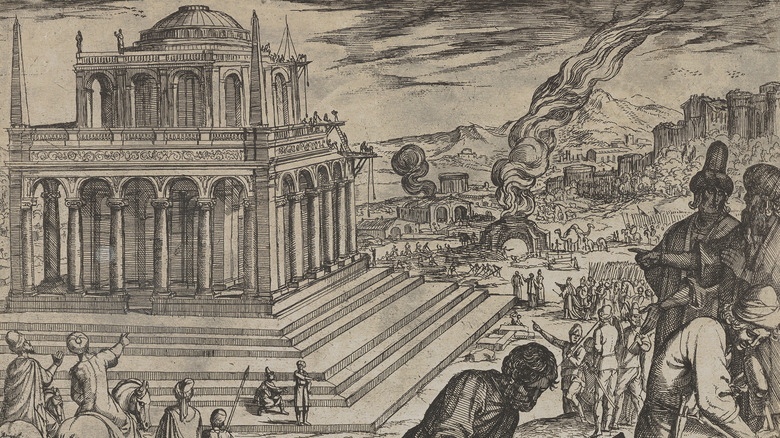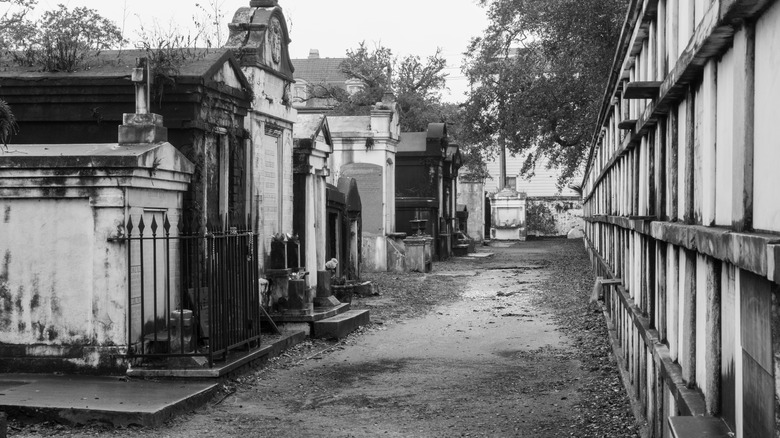What Exactly Is A Mausoleum?
Grave. Tomb. Cemetery. Crypt. Mausoleum. If the exact differences between these terms aren't clear, we at least understand that they refer to the methods and locations that people use to inter the dead. They do not, however, include body disposal methods like cremation, "burying" someone at sea, lesser-used practices like human composting, or more unusual customs like sky burials, aka leaving a body exposed to the elements for carrion eaters like vultures to pick apart. That being said, mausoleums do stand out from the crowd if only for one particular reason: The person inside isn't under the ground.
Ultimately, that single fact defines what a mausoleum is and why it differs from other interment methods. And note: This is why we say "inter" and not "bury," because no one is buried in a mausoleum. As Trusted Caskets explains, mausoleums are "freestanding monuments" — buildings that double as decorative tombs — used to house the dead above ground. In a mausoleum, the dead can be placed in a casket, in the wall (a cubby), or even cremated and placed in an urn. Or, a mausoleum can connect to subterranean chambers that contain any of the above — such chambers are crypts. Plus, some mausoleums like the Taj Mahal get the grand and gorgeous treatment to honor notable or praiseworthy people.
Making sure the dead get noticed
Even though mausoleums come in all shapes, sizes, structures, and levels of grandiosity, it makes sense why the wealthy and powerful were the first to build mausoleums to honor, well, themselves. The Persian ruler Mausolus — after whom we get the word "mausoleum" — was the first in recorded history to build a mausoleum to house his own dead body in the mid-4th-century B.C.E. Located in modern-day Turkey, the Mausoleum at Halicarnassus — as it came to be commonly called — was considered one of the seven wonders of the ancient world.
Bear in mind, though, that rulers had been building big things to memorialize their lives for thousands of years, like King Gilgamesh in "The Epic of Gilgamesh" some 4,000 years ago, as Yale University Press describes. The poem starts and ends with praise for the strength of the city of Uruk and its wall, which was Gilgamesh's ticket to symbolic immortality. The Persian ruler Mausolus just took the baton and was apparently the first to think, "Hey, what if I put *me* in that big thing I built?" What better way for the wealthy and powerful to ensure that no one forgets them than a giant building that's kind of hard to ignore? But even if a mausoleum is smaller or more modest, it still functions as a part-memorial, part-interment structure for the dead that sits above ground.
All different, all hygienically similar
As soon as the basic mausoleum criteria are covered — above ground, memorial — mausoleums can come in practically any form. As mentioned, the most famous mausoleum in the world is likely the Taj Mahal in Uttar Pradesh, India. Others include the Mausoleum of Hadrian in Rome and the Lenin Mausoleum in Moscow. On the flip side of ostentatiousness, we've got small, cubical mausoleums like those found across cemeteries in New Orleans. Such mausoleums are packed together on one, enclosed patch of cemetery grounds.
Mausoleums can vary not only on the outside but on the inside, too. A mausoleum can be built for one person, multiple people, or even entire families. There can also be grounds outside of a mausoleum's main structure — like a garden — that are considered part of the entire mausoleum.
But no matter how different, all mausoleums share a critical central feature: Design and engineering that keeps things hygienic. After all, dead bodies decomposing above ground can get unsanitary, and quickly. A Good Goodbye describes how a "successful entombment" needs robust sealing systems, proper ventilation, and materials that last. Casket Questions also talks about differences in preservation between casket types, like metal versus wood, and states that a well-built mausoleum can preserve a body for a long, long time. And yet, as testimonials on Beyond the Pall assert, even the best mausoleum carry a sickly sweet scent of decay.


